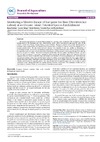Please use this identifier to cite or link to this item:
https://accedacris.ulpgc.es/handle/10553/55565
| Title: | Monitoring a Massive Escape of European Sea Bass (Dicentrarchus Labrax) at an Oceanic Island: Potential Species Establishment | Authors: | Ramirez, Besay Ortega, Leonor Montero, Daniel Tuya, Fernando Haroun, Ricardo |
UNESCO Clasification: | 251092 Acuicultura marina | Keywords: | Escapees Stomach contents Fatty acids Gonadal development Canary Islands |
Issue Date: | 2015 | Journal: | Journal of Aquaculture Research and Development | Abstract: | The post-escape behavior of aquaculture escapees is a growing topic of research. We monitored a massive escape event of the European sea bass, Dicentrarchus labrax, which occurred at a sea-cage fish farm off the oceanic island of La Palma, Canary Islands, eastern Atlantic. Stomach contents and gonadal development of escapees were analyzed from two islands (Gran Canaria and La Palma) in order to assess the degree of postescape establishment,. We also tested (at both islands), the suitability of fatty acid profiles as biomarkers of aquaculture escapes, processing recaptured escaped fish at a range of distances away from aquaculture facilities. Escaped European sea bass concentrated within breakwaters and decreased in abundance through time after the massive escape at La Palma. Decapod crustaceans (particularly Percnon gibbesi and Rhynchocinetes sp) were the main diet constituents of escapees, followed by fishes (mainly the parrotfish, Sparisoma cretense). Only one spawner male was found. Crude lipid, oleic acid, linoleic acid, linolenic acid, eicosapentaenoic acid, Σn-9 fatty acids and Σmonounsatured fatty acids showed higher values in cultured or escaped individuals near cages relative to fish far away from farms. Arachidonic acid, docosahexaenoic acid, Σn-3, satured fatty acids, Σn-3/Σn-6 ratio and Palmitic acid showed the opposite pattern. Our data showed that escaped European sea bass is able to exploit natural recourses, altering their fatty acid profiles relative to farmed conspecifics. The usefulness of fatty acids as biomarkers is, however, limited to a short period of time after escape events. | URI: | https://accedacris.ulpgc.es/handle/10553/55565 | ISSN: | 2155-9546 | DOI: | 10.4172/2155-9546.1000339 | Source: | Journal of Aquaculture Research and Development [ISSN 2155-9546], v. 6 (5), 1000339 |
| Appears in Collections: | Artículos |
Page view(s)
167
checked on Sep 21, 2024
Download(s)
126
checked on Sep 21, 2024
Google ScholarTM
Check
Altmetric
Share
Export metadata
Items in accedaCRIS are protected by copyright, with all rights reserved, unless otherwise indicated.
